Students must practice this TS Intermediate Maths 2B Solutions Chapter 1 Circle Ex 1(e) to find a better approach to solving the problems.
TS Inter 2nd Year Maths 2B Solutions Chapter 1 Circle Exercise 1(e)
I.
Question 1.
Discuss the relative position of the following pair of circles.
(i) x2 + y2 – 4x – 6y – 12 = 0, x2 + y2 + 6x + 18y + 26 = 0
Solution:
Let S ≡ x2 + y2 – 4x – 6y – 12 = 0 ……..(1) and S’ ≡ x2 + y2 + 6x + 18y + 26 = 0 ……..(2) be the given circles.
The Centre of the circle (1) is C1 = (2, 3)
Centre of circle (2) is C2 = (-3, -9)
Radius of circle (1) is \(\sqrt{4+9+12}\) = 5 = r1
Radius of circle (2) is \(\sqrt{9+81-26}\) = 8 = r2
Now C1C2 = \(\sqrt{(2+3)^2+(3+9)^2}\) = 13
and r1 + r2 = 5 + 8 = 13
Since C1C2 = r1 + r2, the two circles touched each other externally.
(ii) x2 + y2 + 6x + 6y + 14 = 0, x2 + y2 – 2x – 4y – 4 = 0
Solution:
Taking S ≡ x2 + y2 + 6x + 6y + 14 = 0 ……….(1) and S’ ≡ x2 + y2 – 2x – 4y – 4 = 0 ………(2)
The Centre of the circle (1) is C11 = (-3, -3)
and the Centre of the circle (2) is C2 = (1, 2)
Radius of circle (1) is r1 = \(\sqrt{9+9-14}\) = 2
Radius of circle (2) is r2 = \(\sqrt{1+4+4}\) = 3
Now C1C2 = \(\sqrt{(1+3)^2+(2+3)^2}\) = √41
r1 + r2 = 5
Since C1C2 > r1 + r2, each circle lies on the exterior of the other circle.
(iii) (x – 2)2 + (y + 1)2 = 9, (x + 1)2 + (y – 3)2 = 4
Solution:
The equation of the given circles are
(x – 2)2 + (y + 1)2 = 9 ………(1)
(x + 1)2 + (y – 3)2 = 4 ……….(2)
Centre of circle (1) is C1 = (2, -1)
The Centre of the circle (2) is C2 = (-1, 3)
The radius of the circle (1) is r1 = 3
The radius of the circle (2) is r2 = 2
C1C2 = \(\sqrt{(2+1)^2+(-1-3)^2}\) = 5
and r1 + r2 = 3 + 2 = 5
∴ Since C1C2 = r1 + r2, the two circles touch each other externally.
(iv) x2 + y2 – 2x + 4y – 4 = 0, x2 + y2 + 4x – 6y – 3 = 0
Solution:
Given equations of circles are
x2 + y2 – 2x + 4y – 4 = 0 ……….(1)
x2 + y2 + 4x – 6y – 3 = 0 ……….(2)
Centre of circle (1) is C1 = (1, -2)
The Centre of the circle (2) is C2 = (-2, 3)
Radius of circle (1) is r1 = \(\sqrt{1+4+4}\) = 3
Radius of circle (2) is r2 = \(\sqrt{4+9+3}\) = 4
Distance between centres C1C2 = \(\sqrt{(1+2)^2+(-2-3)^2}=\sqrt{9+25}=\sqrt{34}\)
r1 + r2 = 3 + 4 = 7 and |r1 – r2| = |3 – 4| = 1
∴ |r1 – r2| < C1C2 < r1 + r2
∴ The two given circles (1) and (2) intersect each other in two points.
![]()
Question 2.
Find the number of possible common tangents that exist for the following pairs of circles.
(i) x2 + y2 + 6x + 6y + 14 = 0, x2 + y2 – 2x – 4y – 4 = 0
Solution:
The given equations of circles are
x2 + y2 + 6x + 6y + 14 = 0 ………(1)
and x2 + y2 – 2x – 4y – 4 = 0 ……..(2)
Centre of circle (1) is C1 = (-3, -3)
The Centre of the circle (2) is C2 = (1, 2)
Radius of circle (1) is r1 = \(\sqrt{9+9-14}\) = 2
Radius of circle (2) is r2 = \(\sqrt{1+4+4}\) = 3
C1C2 = \(\sqrt{(-3-1)^2+(-3-2)^2}=\sqrt{16+25}\) = √41
and r1 + r2 = 2 + 3 = 5
Since C1C2 > r1 + r2 the given circles do not intersect each other.
The number of possible common tangents that can be drawn to the above circles is ‘4’.
(ii) x2 + y2 – 4x – 2y + 1 = 0, x2 + y2 – 6x – 4y + 4 = 0
Solution:
The given equations of circles are
x2 + y2 – 4x – 2y + 1 = 0 ………(1)
and x2 + y2 – 6x – 4y + 4 = 0 ……….(2)
The Centre of the circle (1) is C1 = (2, 1)
The Centre of the circle (2) is C2 = (3, 2)
Radius of circle (1) is r1 = \(\sqrt{4+1-1}\) = 2
Radius of circle (2) is r2 = \(\sqrt{9+4-4}\) = 3
C1C2 = \(\sqrt{(2-3)^2+(1-2)^2}=\sqrt{1+1}=\sqrt{2}\)
and r1 + r2 = 2 + 3 = 5
∴ |r1 – r2| = |2 – 3| = 1
∴ |r1 – r2| < C1C2 < r1 + r2
∴ The two given circles intersect each other in two points.
The number of possible common tangents that can be drawn to the circles is ‘2’.
(iii) x2 + y2 – 4x + 2y – 4 = 0, x2 + y2 + 2x – 6y + 6 = 0
Solution:
The given equations of circles are
x2 + y2 – 4x + 2y – 4 = 0 ……….(1)
and x2 + y2 + 2x – 6y + 6 = 0 …………(2)
Centre of circle (1) is C1 = (2, -1)
The Centre of the circle (2) is C2 = (-1, 3)
Radius of circle (1) is r1 = \(\sqrt{4+1+4}\) = 3
Radius of circle (2) is r2 = \(\sqrt{1+9-6}\) = 2
C1C2 = \(\sqrt{(2+1)^2+(-1-3)^2}=\sqrt{9+16}\) = 5
and r1 + r2 = 3 + 2 = 5
Since C1C2 = r1 + r2, the two circles touch externally and the number of possible common tangents is ‘3’.
(iv) x2 + y2 = 4, x2 + y2 – 6x – 8y + 16 = 0
Solution:
The equations of given circles are x2 + y2 = 4 ………(1) and x2 + y2 – 6x – 8y + 16 = 0 ……….(2)
The Centre of the circle (1) is C1 = (0, 0)
The Centre of the circle (2) is C2 = (3, 4)
The radius of the circle (1) is r1 = 2
Radius of circle (2) is r2 = \(\sqrt{9+16-16}\) = 3
C1C2 = \(\sqrt{9+16}\) = 5 = r1 + r2
Hence the two circles touch externally and the number of possible common tangents is ‘3’.’
(v) x2 + y2 + 4x – 6y – 3 = 0, x2 + y2 + 4x – 2y + 4 = 0
Solution:
The equations of circles are
x2 + y2 + 4x – 6y – 3 = 0 ……….(1)
and x2 + y2 + 4x – 2y + 4 = 0 ……….(2)
The Centre of the circle (1) is C1 = (-2, 3)
The Centre of the circle (2) is C2 = (-2, 1)
Also radius of circle are r1 = \(\sqrt{4+9+3}\) = 4
Radius of circle (2) are r2 = \(\sqrt{4+1-4}\) = 1
Now C1C2 = \(\sqrt{(-2+2)^2+(3-1)^2}\) = 4
and |r1 – r2| = |4 – 1| = 3
∴ C1C2 < |r1 + r2|, one circle lies completely inside the other circle.
∴ The number of common tangents that can be drawn to the circles S = 0 and S’ = 0 is zero.
![]()
Question 3.
Find the internal centre of similitude of the circles x2 + y2 + 6x – 2y + 1 = 0 and x2 + y2 – 2x – 6y + 9 = 0.
Solution:
Equations of given circles are
x2 + y2 + 6x – 2y + 1 = 0 ……….(1)
x2 + y2 – 2x – 6y + 9 = 0 ……….(2)
The Centre of the circle (1) is C1 = (-3, 1)
The Centre of the circle (2) is C2 = (1, 3)
Also radius of circle (1) is r1 = \(\sqrt{9+1-1}\) = 3
radius of circle (2) is r2 = \(\sqrt{1+9-9}\) = 1
Now C1C2 = \(\sqrt{(-3-1)^2+(1-3)^2}=\sqrt{16+4}\) = √20
and r1 + r2 = 3 + 1 = 4
Since C1C2 > r1 + r2, the two circles do not touch or do not intersect each other but each circle lies in the exterior of the other.
∴ Number of common tangents = 4
Both internal and external centres of similitude exist.

Let A be the internal centre of similitude and r1 : r2 = 3 : 1.
∴ A divides \(\overline{\mathrm{C}_1 \mathrm{C}_2}\) in the ratio 3 : 1 internally.
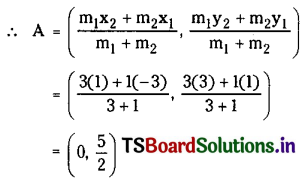
∴ The internal centre of similitude is (0, \(\frac{5}{2}\))
Question 4.
Find the external centre of similitude for the circles x2 + y2 – 2x – 6y + 9 = 0, x2 + y2 = 4.
Solution:
The equations of given circles are x2 + y2 – 2x – 6y + 9 = 0 ……..(1) and x2 + y2 = 4 ……..(2)
Centre of circles are C1 = (1, 3) and C2 = (0, 0)
Radius of circles are r1 = \(\sqrt{1+9-9}\) = 1 and r2 = √4 = 2
Now C1C2 = \(\sqrt{1+9}=\sqrt{10}\) and r1 + r2 = 1 + 2 = 3
Since C1C2 > r1 + r2, each circle lies in the exterior of the other circle, and the number of common tangents = 4
∴ Both internal and external centres of similitudes do exist in this case.
C1 = (1, 3) = (x1, y1) and C2 = (0, 0) = (x2, y2)

∴ The external centre of the similitude of the circle is (2, 6).
II.
Question 1.
(i) Show that the circles x2 + y2 – 6x – 2y + 1 = 0, x2 + y2 + 2x – 8y + 13 = 0 touch each other. Find the point of contact and the equation of the common tangent at their point of contact. (Mar. ’11, ’10, ’09)
Solution:
Let S = x2 + y2 – 6x – 2y + 1 = 0 and S’ = -x2 + y2 + 2x – 8y + 13 = 0 be the given circles.
The centre of circles are C1 = (3, 1) and C2 = (-1, 4)
Radius of circles are r1 = \(\sqrt{9+1-1}\) = 3 and r2 = \(\sqrt{1+16-13}\) = 2
Distance between centres C1C2 = \(\sqrt{(3+1)^2+(1-4)^2}=\sqrt{16+9}\) = 5 and r1 + r2 = 3 + 2 = 5
Since C1C2 = r1 + r2, the two circles touch externally at a point.
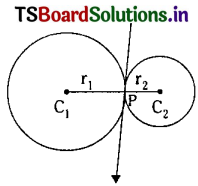
Let P be the point of contact of circles such that r1 : r2 = 3 : 2.
Since P divides C1, C2 internally in the ratio 3 : 2,
the coordinates of the point of contact
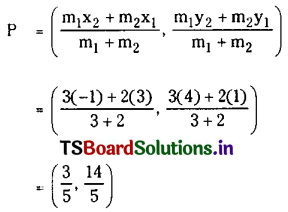
The equation of common tangent is S – S’ = 0
⇒ x2 + y2 – 6x – 2y + 1 – x2 – y2 – 2x + 8y + 13 = 0
⇒ -8x + 6y – 12 = 0
⇒ 4x – 3y + 6 = 0
∴ The equation of the common tangent at the point of contact is 4x – 3y + 6 = 0.
(ii) Show that x2 + y2 – 6x – 9y + 13 = 0, x2 + y2 – 2x – 16y = 0 touch each other. Find the point of contact and the equation of the common tangent at their point of contact.
Solution:
Given equations of circles are S = x2 + y2 – 6x – 9y + 13 = 0 and S’ = x2 + y2 – 2x – 16y = 0
Centre of circles are C1 = (3, \(\frac{9}{2}\)) and C2 = (1, 8)
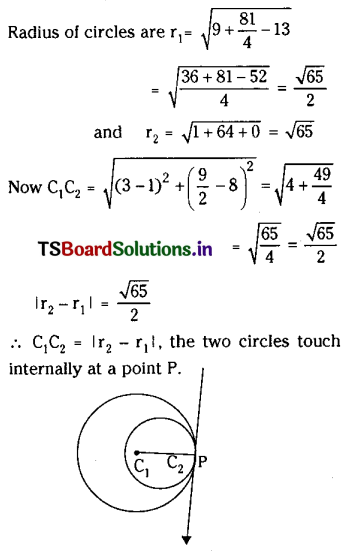
The point P divides C1C2 externally in the ratio of their radius \(\frac{\sqrt{65}}{2}\) : √65 = 1 : 2

The equation of the common tangent at P(5, 1) to the circles S = 0 and S’ = 0 is S – S’ = 0.
⇒ x2 + y2 – 6x – 9y + 13 – x2 – y2 + 2x + 16y = 0
⇒ -4x + 7y – 13 = 0
⇒ 4x – 7y + 13 = 0
∴ The equation of the required common tangent is 4x – 7y + 13 = 0.
![]()
Question 2.
Find the equation of the circle which touches the circle x2 + y2 – 2x – 4y – 20 = 0 externally at (5, 5) with radius ‘5’.
Solution:

Let C1 = (h, k) be the centre and r1 be the radius of the required circle.
Given r1 = 5
Equation of the given circle is x2 + y2 – 2x – 4y – 20 = 0 ……….(1)
Centre of the circle C2 = (1, 2) and radius r2 = \(\sqrt{1+4+20}\) = 5
∴ r1 : r2 = 5 : 5 = 1 : 1
Point P(5, 5) divides C1C2 in the ratio 1 : 1 internally.
∴ \(\left(\frac{\mathrm{h}+1}{2}, \frac{\mathrm{k}+2}{2}\right)\) = (5, 5)
⇒ \(\frac{\mathrm{h}+1}{2}\) = 5 and \(\frac{\mathrm{k}+2}{2}\) = 5
⇒ h = 9 and k = 18
∴ C1 = (h, k) = (9, 8)
∴ The equation of a required circle with centre (9, 8) and radius ‘5’ is (x – 9)2 + (y – 8)2 = 25
⇒ x2 + y2 – 18x – 16y + 120 = 0
Question 3.
Find the direct common tangents of the circles x2 + y2 + 22x – 4y – 100 = 0 and x2 + y2 – 22x + 4y + 100 = 0. (New Model Paper)
Solution:
Let S = x2 + y2 + 22x – 4y – 100 = 0 ……….(1) and S’ = x2 + y2 – 22x + 4y + 100 = 0 …….(2) be the given circles.
Then centres of the circles are C1 = (-11, +2) and C2 = (11, -2)
The radius of the circles are

and r1 + r2 = 15 + 5 = 20
Since C1C2 > r1 + r2, the two circles are such that each lies on the exterior of the other.
Hence both internal and external centre of similitude exists.

Now r1 : r2 = 15 : 5 = 3 : 1
Point P divides C1, C2 externally in the ratio of radii 3 : 1.
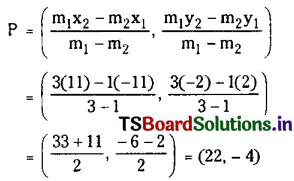
The equation of direct common tangent passing through (22, -4) having slope ‘m’ is y + 4 = m(x – 22)
⇒ mx – y – 4 – 22m = 0 …….(1)
Since the line is tangent to S’ = 0.
Perpendicular distance from C2 = (11, -2) to the line (1) = radius of the circle S’ = 0
∴ \(\left|\frac{m(11)+2-4-22 m}{\sqrt{m^2+1}}\right|\) = 5
⇒ \(\left|\frac{-(11 m+2)}{\sqrt{m^2+1}}\right|\) = 5
⇒ (11m + 2)2 = 25(m2 + 1)
⇒ 121m2 + 44m + 4 = 25m2 + 25
⇒ 96m2 + 44m – 21 = 0
⇒ 96m2 + 72m – 28 m – 21 = 0
⇒ 24m(4m + 3) – 7(4m + 3) = 0
⇒ (24m – 7) (4m + 3) = 0
⇒ m = \(\frac{-3}{4}\) or m = \(\frac{7}{24}\)
∴ Equations of direct common tangents from (1) are y + 4 = \(\frac{-3}{4}\)(x – 22)
⇒ 4y + 16 = -3x + 66
⇒ 3x + 4y – 50 = 0
and y + 4 = \(\frac{7}{24}\)(x – 22)
⇒ 24y + 96 = 7x – 154
⇒ 7x – 24y – 250 = 0
∴ The equations of direct common tangents are given by 3x + 4y – 50 = 0 and 7x – 24y – 250 = 0.
![]()
Question 4.
Find the transverse common tangents of the circles x2 + y2 – 4x – 10y + 28 = 0 and x2 + y2 + 4x – 6y + 4 = 0.
Solution:
Let S = x2 + y2 – 4x – 10y + 28 = 0 ………(1)
S’ = x2 + y2 + 4x – 6y + 4 = 0 ……….(2)
be the given circles.
Centres of the circles are C1 = (2, 5) and C2 = (-2, 3)
Also, the radius of circles are r1 = \(\sqrt{4+25-28}\) = 1 and r2 = \(\sqrt{4+9-4}\) = 3
Also C1C2 = \(\sqrt{(2+2)^2+(5-3)^2}\) = √20 = 2√5 and r1 + r2 = 4
Since C1C2 > r1 + r2, we have each circle lying in the exterior of other circles.
Hence we get 2 direct common tangents and 2 transverse common tangents that can be drawn.
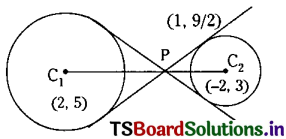
Point P divides C1C2 internally in the ratio r1 : r2 = 1 : 3.
Let P be the internal centre of similitude.

Let the equation of transverse common tangent be y – \(\frac{9}{2}\) = m(x – 1) ……(1)
⇒ 2y – 9 = 2mx – 2m
⇒ 2mx – 2y + (9 – 2m) = 0 ……….(2)
Since line (2) is a tangent to the circle S = 0, the perpendicular distance from C1 (2, 5) to line (2) is equal to the radius of the circle S = 0.
∴ \(\left|\frac{2 m(2)-2(5)+9-2 m}{\sqrt{4 m^2+4}}\right|\) = 1
⇒ |2m – 1| = \(2 \sqrt{m^2+1}\)
⇒ 4m2 – 4m + 1 = 4(m2 + 1)
⇒ 4m2 – 4m + 1 – 4m2 – 4 = 0
⇒ -4m – 3 = 0
⇒ m = \(\frac{-3}{4}\)
∴ Equation of tangent is y – \(\frac{9}{2}\) = \(\frac{-3}{4}\)(x – 1)
⇒ \(\frac{2 y-9}{2}=-\frac{3}{4}(x-1)\)
⇒ 2(2y – 9) = -3(x – 1)
⇒ 4y – 18 = -3x + 3
⇒ 3x + 4y – 21 = 0
Since the m2 term is canceled, the slope of one of the transverse common tangents is not defined.
One transverse common tangent is passing through P(1, \(\frac{9}{2}\)) and parallel to y-axis.
∴ The equation of other transverse common tangents is x = 1.
∴ The equations of transverse common tangents are x = 1 and 3x + 4y – 21 = 0.
Question 5.
Find the pair of tangents from (4, 10) to the circle x2 + y2 = 25.
Solution:
Let P(x1, y1) be the given point.
The equation to the pair of tangents drawn from P(4, 10) to S = 0 is \(\mathrm{S}_1^2=\mathrm{SS}_{11}\).
Given S = x2 + y2 – 25 = 0
(xx1 + yy1 – 25)2 = (x2 + y2 – 25) (\(x_1^2+y_1^2\) – 25)
⇒ (4x + 10y – 25)2 = (x2 + y2 – 25) (16 + 100 – 25)
⇒ (4x + 10y – 25)2 = (x2 + y2 – 25) (91)
⇒ 16x2 + 100y2 + 625 + 80xy – 500y – 200x = 91x2 + 91y2 – 2275
⇒ 75x2 – 9y2 – 80xy + 200x + 500y – 2900 = 0
![]()
Question 6.
Find the pair of tangents drawn from (0, 0) to x2 + y2 + 10x + 10y + 40 = 0.
Solution:
Let P(x1, y1) be the given point.
The equation to the pair of tangents drawn from P(0, 0) to S = 0 is \(\mathrm{S}_1^2=\mathrm{SS}_{11}\).
Given S = x2 + y2 + 10x + 10y + 40 = 0
∴ The equation to the pair of tangents from (0, 0) to S = 0 is [xx1 + yy1 + g(x + x1) + f(y + y1) + c]2 = (x2 + y2 + 2gx + 2fy + c) (\(x_1^2+y_1^2\) + 2gx1 + 2fy1 + c)
⇒ (5x + 5y + 40)2 = (x2 + y2 + 10x + 10y + 40) (40)
⇒ 25x2 + 25y2 + 1600 + 50xy + 400xy + 400x = 40(x2 + y2 + 10x + 10y + 40)
⇒ 15x2 + 15y2 – 50xy = 0
⇒ 3x2 + 3y2 – 10xy = 0
III.
Question 1.
Find the equation of the circle which touches x2 + y2 – 4x + 6y – 12 = 0 at (-1, 1) internally with a radius of ‘2’.
Solution:
The given circle is x2 + y2 – 4x + 6y – 12 = 0
The centre of the circle is (2, -3) and radius = \(\sqrt{4+9+12}\) = 5
Let the centre of the required circle be (h, k), and given that 2 is the radius with the point of contact of circles internally as (-1, 1).
Suppose (x1, y1) = (2, -3), (x2, y2) = (h, k), r1 = 5, r2 = 2
point of contact (x, y) = (-1, 1)
using the formula for the external division since two circles touch internally.
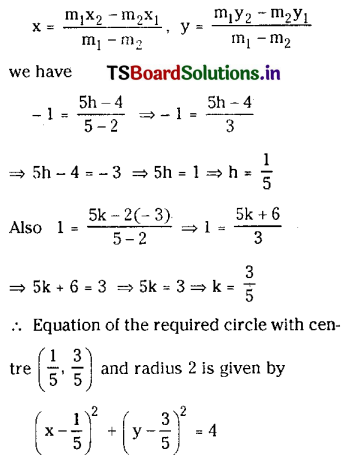
⇒ (5x – 1)2 + (5y – 3)2 = 100
⇒ 25x2 + 25y2 – 10x – 30y – 90 = 0
⇒ 5x2 + 5y2 – 2x – 6y – 18 = 0
Question 2.
Find all common tangents of the following pairs of circles.
(i) x2 + y2 = 9 and x2 + y2 – 16x + 2y + 49 = 0
Solution:
Let S = x2 + y2 – 9 = 0 and S’ = x2 + y2 – 16x + 2y + 49 = 0 be the given circles.
Centre of the circle S = 0 is C1 (0, 0) and radius = 3
Centre of the circle S’ = 0 is C2 (8, -1) and radius r2 = \(\sqrt{64+1-49}\) = 4
r1 + r2 = 3 + 4 = 7 and C1C2 = \(\sqrt{64+1}=\sqrt{65}\) > 7
Since C1C2 > r1 + r2 we get each circle lies completely in the exterior of the other.
∴ Two direct and two transverse common tangents can be drawn to S = 0 and S’ = 0.
r1 : r2 = 3 : 4
Let A be the internal centre of similitude and A divides C1C2 in the ratio 3 : 4 internally

⇒ 64x2 + y2 + 441 – 16xy + 42y – 336x = 16(x2 + y2 – 9)
⇒ 48x2 – I6xy – 15y2 + 42y – 336x + 585 = 0
⇒ 48x2 – 36xy + 20xy – 15y2 + 42y – 336x + 585 = 0
⇒ 12x(4x – 3y) + 5y(4x – 3y) + 42y – 336x + 585 = 0
⇒ (12x + 5y)(4x – 3y) – 336x + 42y + 585 = 0
Let 48x2 – 16xy – 15y2 + 42y – 336x + 585 = (12x + 5y + l) (4x – 3y + m)
= 48x2 – 36xy + 12mx + 20xy – 15y2 + 5ym + 4lx + 3ly + lm
= 48x2 – 16xy – 15y2 + (4l + 12m)x + (-3l + 5m)y + lm
Equating coefficients of x, y, and the constant term
4l + 12m = -336
⇒ l + 3m = -84 ………(1)
-3l + 5m = 42
⇒ 3l – 5m = -42 ……..(2)
and lm = 585 …….(3)
From (1), 5l + 15m = -420
From (2), 9l – 15m = -126
∴ 14l = -546
⇒ l = -39
From (1), -39 + 3m = -84
⇒ 3m = -45
⇒ m = -15
∴ 48x2 – 16xy – 15y2 + 42y – 336x + 585 = (12x + 5y – 39) (4x – 3y – 15)
∴ The transverse common tangents are 12x + 5y – 39 = 0 and 4x – 3y – 15 = 0
Let B be the external centre of the similitude of circles.
∴ B divides C1C2 in the ratio 3 : 4 externally
∴ B = \(\left(\frac{3(8)-4(0)}{3-4}, \frac{3(-1)-4(0)}{3-4}\right)\) = (-24, 3)
The equation is the pair of direct common tangents to the circle S = 0 from (-24, 3) is \(S_1^2=S S_{11}\)
⇒ [x(-24) + y(3) – 9]2 = (x2 + y2 – 9) (576 + 9 – 9)
⇒ (-24x + 3y – 9)2 = (576) (x2 + y2 – 9)
⇒ 9(-8x + y – 3)2 = 9 × 64 (x2 + y2 – 9)
⇒ (-8x + y – 3)2 = 64(x2 + y2 – 9)
⇒ 64x2 + y2 + 9 – 16xy – 6y + 48x = 64x2 + 64y2 – 576
⇒ 63y2 + 16xy – 48x + 6y – 585 = 0
⇒ y(63y + 16x) – 48x + 6y – 585 = 0
∴ 63y2 + 16xy – 48x + 6y – 585 = (y + l) (63y + 16x + m)
Equating coefficients of x, y, and constants
16l = 48 ……..(4)
63l + m = 6 ………(5)
lm = -585 ……….(6)
∴ l = -3 and from (6), m = 195
∴ 63y2 + 16xy – 48x + 6y – 585 = (y – 3) (63y + 16x + 195)
∴ The equations of direct common tangents to the circles S = 0, S’ = 0 are y – 3 = 0, 63y + 16x + 195 = 0.
Hence equations of all common tangents to the circles S = 0 and S’ = 0 are 4x – 3y – 15 = 0, 12x + 5y – 39 = 0 and y – 3 = 0, 16x + 63y + 195 = 0.
(ii) x2 + y2 + 4x + 2y – 4 = 0 and x2 + y2 – 4x – 2y + 4 = 0
Solution:
Let S = x2 + y2 + 4x + 2y – 4 = 0 and S’ = x2 + y2 – 4x – 2y + 4 = 0
Centre of S = 0 is C1 (-2, 1) and the radius is r1 = \(\sqrt{4+1+4}\) = 3
Centre of S’ = 0 is C2 (2, 1) and the radius r2 = \(\sqrt{4+1-4}\) = 1
Also C1C2 = \(\sqrt{(2+2)^2+(1+1)^2}=\sqrt{16+4}\) = √20 = 2√5 and r1 + r2 = 3 + 1 = 4
Since C1C2 > r1 + r2, each circle lies in the exterior of the other circle.
∴ Two direct and two transverse common tangents can be drawn to the circles S = 0 and S’ = 0.
Let A, B be the internal and external centres of similitudes of circles S = 0 and S’ = 0
A divides \(\overline{\mathrm{C}_1 \mathrm{C}_2}\) in the ratio r1 : r2 = 3 : 1 internally
∴ A = \(\left(\frac{m_1 x_2+m_2 x_1}{m_1+m_2}, \frac{m_1 y_2+m_2 y_1}{m_1+m_2}\right)\)
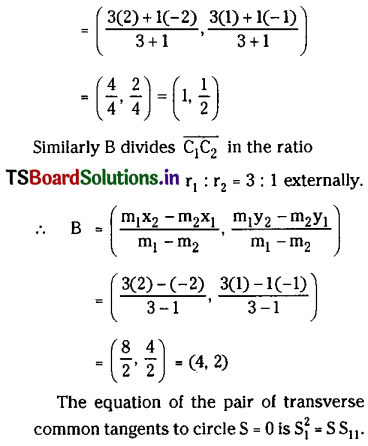
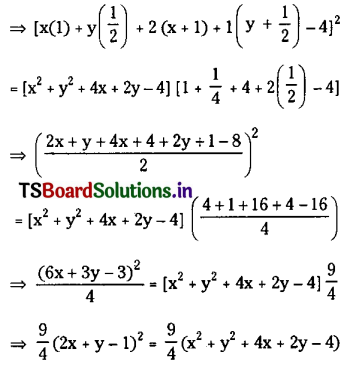
⇒ -(2x + y – 1)2 = (x2 + y2 + 4x + 2y – 4)
⇒ (2x + y – 1)2 = (x2 + y2 + 4x + 2y – 4)
⇒ 4x2 + y2 + 1 + 4xy – 2y – 4x = x2 + y2 + 4x + 2y – 4
⇒ 3x2 + 4xy – 8x – 4y + 5 = 0
⇒ x(3x + 4y) – 8x – 4y + 5 = 0
⇒ 3x2 + 4xy – 8x – 4y + 5 = (x + l) (3x + 4y + m)
Comparing the coefficients of x, y, and constants
3l + m = -8 ………(1)
4l = -4 ……….(2)
lm = 5 ……….(3)
∴ From (2), l = -1 and From (3), m = -5
∴ 3x2 + 4xy – 8x – 4y + 5 = (x – 1) (3x + 4y – 5)
The equations of transverse common tangents are x – 1 = 0, 3x + 4y – 5 = 0.
The equation of pair of direct common tangents to the circle S = 0 is \(\mathrm{s}_1^2=\mathrm{S} \mathrm{S}_{11}\).
⇒ [x(4) + y(2) + 2(x + 4) + 1(y + 2) – 4]2 = (x2 + y2 + 4x + – 2y – 4) (16 + 4 + 16 + 4 – 4)
⇒ (6x + 3y + 6)2 = (x2 + y2 + 4x + 2y – 4)(36)
⇒ 9(2x + y + 2)2 = 36(x2 + y2 + 4x + 2y – 4)
⇒ (2x + y + 2)2 = 4(x2 + y2 + 4x + 2y – 4)
⇒ 4x2 + y2 + 4 + 4xy + 4y + 4x = 4x2 + 4y2 + 16x + 8y – 16
⇒ 3y2 – 4xy + 8x + 4y – 20 = 0
⇒ y(3y – 4x) + 8x + 4y – 20 = 0
∴ 3y2 – 4xy + 8x + 4y – 20 = (y + l) (3y – 4x + m)
Comparing coefficients of x, y, and constants we get
-4l = 8 ………(4)
3l + m = 4 ………(5)
lm = -20 ………(6)
From (4), l = -2 and from (6), m = 10
∴ 3y2 – 4xy + 8x + 4y – 20 = (y – 2) (3y – 4x + 10)
Hence the equations of direct common tangents are y – 2 = 0, 3y – 4x + 10 = 0.
∴ The equations of all common tangents to the circles S = 0, S’ = 0 are x – 1 = 0, 3x + 4y – 5 = 0 and y – 2 = 0, 4x – 3y – 10 = 0
![]()
Question 3.
Find the pair of tangents drawn from (3, 2) to the circle x2 + y2 – 6x + 4y – 2 = 0.
Solution:
Let S ≡ x2 + y2 – 6x + 4y – 2 = 0 be the given circle.
The equation of pair of tangents drawn from (3, 2) to the circle S = 0 is \(S_1^2=S . S_{11}\)
⇒ [x(3) + y(2) – 3(x + 3) + 2(y + 2) – 2]2 = (x2 + y2 – 6x + 4y – 2) (32 + 22 – 18 + 8 – 2)
⇒ (4y – 7)2 = 1 . (x2 + y2 – 6x + 4y – 2)
⇒ 16y2 – 56y + 49 = x2 + y2 – 6x + 4y – 2
⇒ x2 – 15y2 – 6x + 60y – 51 = 0
Question 4.
Find the pair of tangents drawn from (1, 3) to the circle x2 + y2 – 2x + 4y – 11 = 0 and also find the angle between them.
Solution:
Denote S ≡ x2 + y2 – 2x + 4y – 11 = 0
The equation of pair of tangents from (1, 3) to the circle S = 0 is by the formula \(S_1^2=S . S_{11}\)
⇒ [x(1) + y(3) – (x + 1) + 2(y + 3) – 11]2 = (x2 + y2 – 2x + 4y – 11) (12 + 32 – 2 + 12 – 11)
⇒ (5y – 6)2 = (x2 + y2 – 2x + 4y – 11) (9)
⇒ 25y2 – 60y + 36 = 9x2 + 9y2 – 18x + 36y – 99
⇒ 9x2 – 16y2 – 18x + 96y – 135 = 0
If θ is the angle between the above pair of tangents to S = 0, then
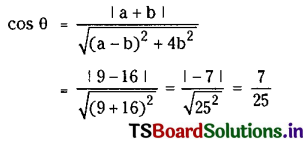
(or) θ = \(\cos ^{-1}\left(\frac{7}{25}\right)\) is the angle between pair of tangents to S = 0.
Question 5.
Find the pair of tangents from the origin to the circle x2 + y2 + 2gx + 2fy + c = 0 and hence deduce a condition for these tangents to the perpendicular.
Solution:
Let S ≡ x2 + y2 + 2gx + 2fy + c = 0 be the given circle.
Then the equation of the pair of tangents drawn from (0, 0) to S = 0 is by the formula \(S_1^2=S . S_{11}\)
⇒ [x(0) + y(0) + g(x + 0) + f(y + 0) + c]2 = (x2 + y2 + 2gx + 2fy + c) (c)
⇒ (gx + fy + c)2 = cx2 + cy2 + 2gcx + 2fcy + c2
⇒ (g2x2 + f2y2 + c2 + 2fgxy + 2fcy + 2cgx) = cx2 + cy2 + 2gcx + 2fcy + c2
⇒ x2(g2 – c) + y2(f2 – c) + 2fgxy = 0
Given that pair of tangents represented by this equation are perpendicular we have
coefficient of x2 + coefficient of y2 = 0
⇒ g2 – c + f2 – c = 0
⇒ g2 + f2 = 2c
![]()
Question 6.
From a point on the circle x2 + y2 + 2gx + 2fy + c = 0 two tangents are drawn to the circle x2 + y2 + 2gx + 2fy + c sin2α + (g2 + f2) cos2α = 0 (0 < α < π/2). Prove that the angle between them is 2α.
Solution:
Let S = x2 + y2 + 2gx + 2fy + c = 0 and S’ = x2 + y2 + 2gx + 2fy + c sin2α + (g2 + f2) cos2α = 0 be the given circles.
Let P(x1, y1) be any point on S = 0 then
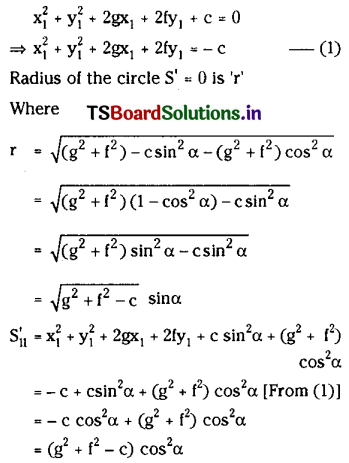
Let θ be the angle between the tangents drawn from P(x1, y1) to S’ = 0 then
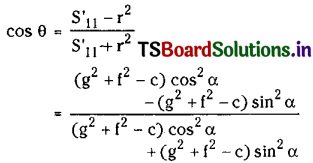
= \(\frac{\left(g^2+f^2-c\right)\left(\cos ^2 \alpha-\sin ^2 \alpha\right)}{\left(g^2+f^2-c\right)\left(\cos ^2 \alpha+\sin ^2 \alpha\right)}\)
= cos 2α
∴ cos θ = cos 2α ⇒ θ = 2α
∴ The angle between the tangents drawn from P(x1, y1) to the circle S’ = 0 is 2α.